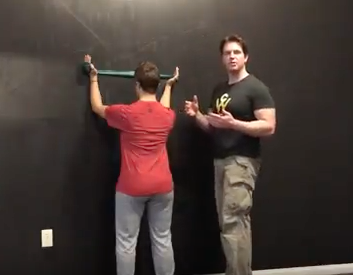The ability to perform a full, pain-free squat with your torso at least 60 degrees relative to the ground is an essential component of athleticism. This ability relies on a myriad of mobility and stability qualities that run from the ankle to t-spine. If you can’t maintain a relatively erect torso in the full squat, oftentimes a trainer or therapist will recommend a wall squat to improve your technique.
A quick overview of the wall squat: stand facing a few inches away from a wall with the arms hanging straight down in front, between your legs. With your feet wider than shoulder width and angled out slightly, squat as deep as possible. Stand and repeat.
The wall squat has the potential to be a great drill for people with the right body structure, but most people find it uncomfortable and awkward. It’s not natural to squat down with a wall hitting your face, and it’s too easy to fall backward as you try to maintain an upright torso.
That’s why I’ve merged away from using the wall squat with my clients. These days I use a goblet squat with a lateral shift to mobilize tight hips. By holding a kettlebell or dumbbell at your chest, you create a counterbalance load that allows you to really push your hips back without falling over backward. This counterbalance also allows you to maintain a more erect torso. And since this exercise doesn’t require you to stand directly in front of a wall, you don’t have to worry about that nuisance.
Key Points for the Goblet Squat with Lateral Shift
1. Maintain an arch in your feet: it’s common for people to pronate their feet in the bottom position of a squat. Be cognizant of your arches as soon as you start to descend – don’t let the arches flatten.
2. Push knees out to the side: as soon as you squat focus on pushing your knees out to the sides to avoid valgus collapse (inward movement of knees). Keeping your knees pushed out will also help you maintain an arch in your feet.
3. Maintain an erect torso and neutral head position: there should be a straight line from the base of your neck to your pelvis when you’re in the bottom position of the squat. Have a partner cue you the first few times until you get the feel for the correct position.
4. Relax in the bottom position: when you’re in the bottom position (hole), maintain a normal breathing pattern. If you have to strain or hold your breath the new position won’t stick. After shifting side-to-side four or five times, exhale deeply as you achieve a deeper position.
Now that you know the correct technique, the key point of this exercise is the lateral shifting to mobilize the hips by creating a more intense stretch on the hip capsule and surrounding muscles. I learned the value of the lateral shift many years ago from Pavel Tsatsouline. When you do the lateral shift correctly it induces a feeling that’s similar to hip scouring, a technique that my friend Dr. Trisha Smith frequently performs on me to mobilize my hips.
Use this exercise to not only improve your squat technique, but also your Olympic lifts, lunges, and kicks. Plus, enhancing hip mobility will take stress off your knees and back. Perform this exercise at the beginning of your workouts and anytime you need to loosen your hips.
Stay Focused,
CW


